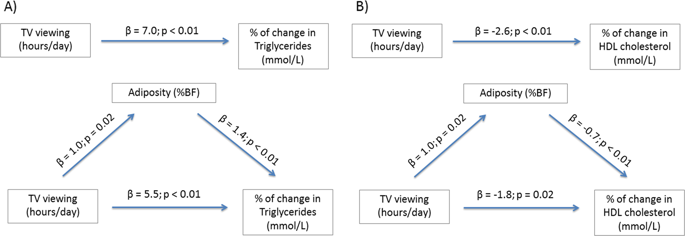当前位置:
X-MOL 学术
›
Int. J. Obesity
›
论文详情
Our official English website, www.x-mol.net, welcomes your
feedback! (Note: you will need to create a separate account there.)
Tune out and turn in: the influence of television viewing and sleep on lipid profiles in children.
International Journal of Obesity ( IF 4.2 ) Pub Date : 2020-03-13 , DOI: 10.1038/s41366-020-0527-5 Despoina Manousaki 1, 2 , Tracie A Barnett 1, 3, 4 , Marie-Eve Mathieu 1, 5 , Katerina Maximova 6 , Gabrielle Simoneau 1, 7 , Soren Harnois-Leblanc 1, 8 , Andrea Benedetti 7, 9 , Jennifer J McGrath 10 , Mélanie Henderson 1, 11 ,
International Journal of Obesity ( IF 4.2 ) Pub Date : 2020-03-13 , DOI: 10.1038/s41366-020-0527-5 Despoina Manousaki 1, 2 , Tracie A Barnett 1, 3, 4 , Marie-Eve Mathieu 1, 5 , Katerina Maximova 6 , Gabrielle Simoneau 1, 7 , Soren Harnois-Leblanc 1, 8 , Andrea Benedetti 7, 9 , Jennifer J McGrath 10 , Mélanie Henderson 1, 11 ,
Affiliation

|
BACKGROUND/OBJECTIVES
Physical activity is beneficial to lipid profiles; however, the association between sedentary behavior and sleep and pediatric dyslipidemia remains unclear. We aimed to investigate whether sedentary behavior or sleep predicted lipid profiles in children over a 2-year period.
SUBJECTS/METHODS
Six hundered and thirty children from the QUALITY cohort, with at least one obese parent, were assessed prospectively at ages 8-10 and 10-12 years. Measures of sedentary behavior included self-reported TV viewing and computer/video game use. Seven-day accelerometry was used to derive sedentary behavior and sleep duration. Adiposity was assessed using DEXA scans. Twenty-four-hour dietary recalls yielded estimates of carbohydrate and fat intake. Outcomes included fasting total cholesterol, triglycerides, HDL and LDL-cholesterol. Multivariable models were adjusted for adiposity and diet.
RESULTS
At both Visit 1 (median age 9.6 year) and Visit 2 (median age 11.6 year), children were of normal weight (55%), overweight (22%), or obese (22%). Every additional hour of TV viewing at Visit 1 was associated with a 7.0% triglyceride increase (95% CI: 3.5, 10.6; P < 0.01) and 2.6% HDL decrease (95% CI: -4.2, -0.9; P < 0.01) at Visit 2; findings remained significant after adjusting for adiposity and diet. Every additional hour of sleep at Visit 1 predicted a 4.8% LDL decrease (95% CI: -9.0, -0.5; P = 0.03) at Visit 2, after adjusting for fat intake; this association became nonsignificant once controlling for adiposity.
CONCLUSIONS
Longer screen time during childhood appears to deteriorate lipid profiles in early adolescence, even after accounting for other major lifestyle habits. There is preliminary evidence of a deleterious effect of shorter sleep duration, which should be considered in further studies.
中文翻译:

调出并上交:看电视和睡眠对儿童血脂的影响。
背景/目的 体力活动有益于血脂;然而,久坐行为与睡眠和小儿血脂异常之间的关联仍不清楚。我们旨在调查久坐行为或睡眠是否能预测 2 年内儿童的血脂状况。对象/方法 来自 QUALITY 队列的 630 名儿童,至少有一个肥胖的父母,在 8-10 岁和 10-12 岁进行了前瞻性评估。久坐行为的测量包括自我报告的电视观看和计算机/视频游戏的使用。7 天加速度计用于推导出久坐行为和睡眠持续时间。使用 DEXA 扫描评估肥胖。24 小时的饮食回忆产生了碳水化合物和脂肪摄入量的估计值。结果包括空腹总胆固醇、甘油三酯、高密度脂蛋白和低密度脂蛋白胆固醇。针对肥胖和饮食调整多变量模型。结果 在访问 1(中位年龄 9.6 岁)和访问 2(中位年龄 11.6 岁)中,儿童体重正常 (55%)、超重 (22%) 或肥胖 (22%)。第 1 次就诊时每多看一小时电视,甘油三酯增加 7.0%(95% CI:3.5、10.6;P < 0.01)和 2.6% HDL 降低(95% CI:-4.2、-0.9;P < 0.01)在访问 2 时;在调整肥胖和饮食后,结果仍然显着。在调整脂肪摄入量后,在第 1 次访问时每多睡一个小时预测第 2 次访问时 LDL 降低 4.8%(95% CI:-9.0,-0.5;P = 0.03);一旦控制肥胖,这种关联就变得不重要了。结论 童年时期较长的屏幕时间似乎会恶化青春期早期的血脂状况,即使考虑到其他主要的生活习惯。有初步证据表明较短的睡眠时间会产生有害影响,应在进一步的研究中加以考虑。
更新日期:2020-04-24
中文翻译:

调出并上交:看电视和睡眠对儿童血脂的影响。
背景/目的 体力活动有益于血脂;然而,久坐行为与睡眠和小儿血脂异常之间的关联仍不清楚。我们旨在调查久坐行为或睡眠是否能预测 2 年内儿童的血脂状况。对象/方法 来自 QUALITY 队列的 630 名儿童,至少有一个肥胖的父母,在 8-10 岁和 10-12 岁进行了前瞻性评估。久坐行为的测量包括自我报告的电视观看和计算机/视频游戏的使用。7 天加速度计用于推导出久坐行为和睡眠持续时间。使用 DEXA 扫描评估肥胖。24 小时的饮食回忆产生了碳水化合物和脂肪摄入量的估计值。结果包括空腹总胆固醇、甘油三酯、高密度脂蛋白和低密度脂蛋白胆固醇。针对肥胖和饮食调整多变量模型。结果 在访问 1(中位年龄 9.6 岁)和访问 2(中位年龄 11.6 岁)中,儿童体重正常 (55%)、超重 (22%) 或肥胖 (22%)。第 1 次就诊时每多看一小时电视,甘油三酯增加 7.0%(95% CI:3.5、10.6;P < 0.01)和 2.6% HDL 降低(95% CI:-4.2、-0.9;P < 0.01)在访问 2 时;在调整肥胖和饮食后,结果仍然显着。在调整脂肪摄入量后,在第 1 次访问时每多睡一个小时预测第 2 次访问时 LDL 降低 4.8%(95% CI:-9.0,-0.5;P = 0.03);一旦控制肥胖,这种关联就变得不重要了。结论 童年时期较长的屏幕时间似乎会恶化青春期早期的血脂状况,即使考虑到其他主要的生活习惯。有初步证据表明较短的睡眠时间会产生有害影响,应在进一步的研究中加以考虑。











































 京公网安备 11010802027423号
京公网安备 11010802027423号